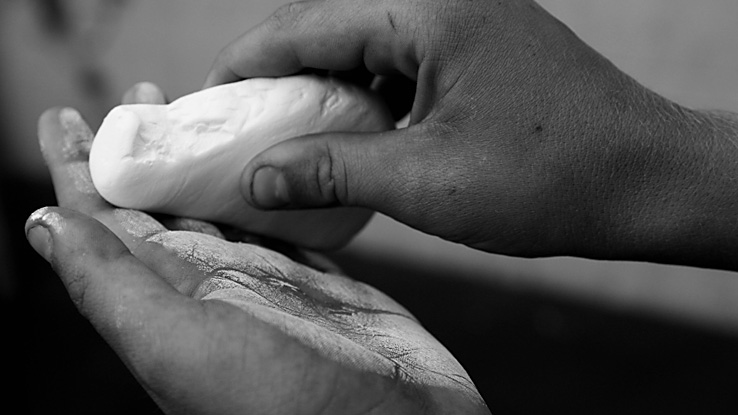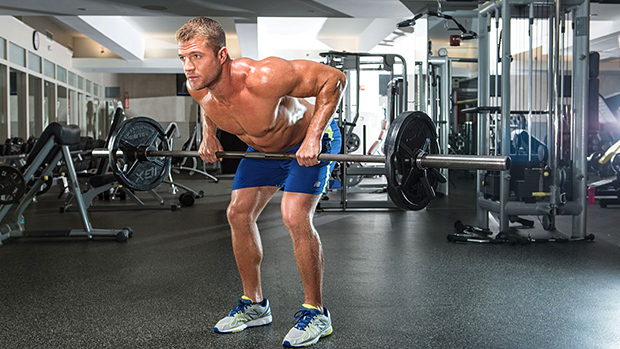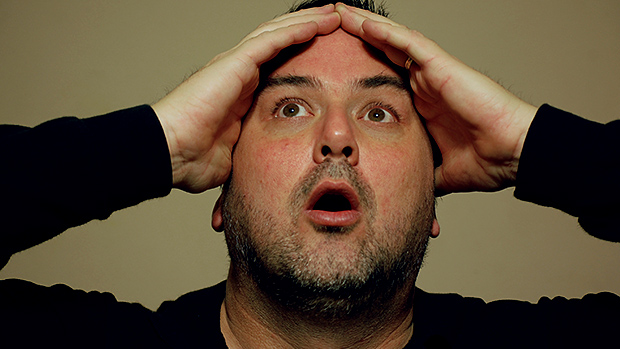Here's what you need to know...
- Regular bench presses often end up causing joint pain, but the reverse-grip bench press (RGBP) can heal your joints and improve your pressing strength.
- If you don't have a spotter, you can safely do the RGBP using safety pins.
- Like anything else, the RGBP takes practice.
The conventional bench press is notorious for contributing to shoulder pain, elbow pain, wrist pain, and even forearm pain. This can lead to missed reps, a decline in strength, and interfere with other lifts.
However, there's a viable yet often misunderstood alternative: the reverse-grip bench press.
The Problem With The Bench Press
When I bench press with the reverse grip, I always get asked, "Why?"
Well, I had no other choice. Conventional bench presses done once or twice per week had gotten me stronger, but with bigger weights came bigger problems.
First it was the shoulders. I'd have pain in my shoulders that shot down through both arms. This forced me to adjust my grip, bringing my hands in closer together. The closer grip, along with tucking the elbows to the body eased the shoulder pain, but it also caused a new problem – pain in my forearms.
In fact, every variation led to other problems and my bench press stalled around the low 300-pound mark. Any more than that would aggravate the pain. That led me to a "drastic" decision: the RGBP.
How To Perform The Reverse-Grip Bench Press
The RGBP is easy to perform and not dangerous when performed correctly, even when done without a spotter.
Set Up And Safety
If you have a reliable training partner who can spot you, great. If not, you need to bench press in a power rack or squat rack to avoid becoming a statistic. I can't tell you how many times the safety pins in my rack have saved me.
Set the safety pins or spotter arms so that they're level with your chest when you lie flat on the bench. You can test this out by lying on the bench, placing the bar on the safety pins, and rolling it above your chest. It should barely make any contact, if at all.
Arching your back and elevating your chest should bring your chest just above the level of the safety pins.

Setting the height of the safety pins at about the same height as your chest forces you to "reach up" with your chest in order for the bar to make contact with your body. You'll need to keep a tight arch to maintain this position, which will allow you to touch the bar to your chest without hitting the safety pins.
If you happen to miss a rep, deflate your chest and the bar will land on the safety pins and make little contact with your body.
Step 1: Grip
Establish your grip first before positioning your body on the bench. Roll the bar forward on the J-hooks (this makes it easier to unrack the bar) and firmly grasp the bar with an underhand grip.
The bar should sit in the heel of your palm directly above the bones of the forearms. In other words, it will rest across the meaty part of your hand on the thumb side across to the very bottom of the palm on the pinky side. Your wrist will be bent back very slightly.
If you grasp the barbell in this fashion and look closely at your hands, wrists, and forearms, you'll notice that your hands are in a slight angle. It's almost like you have an underhand V-grip on a straight bar.
Another way to think of it is it's almost like grabbing the bottom half of a steering wheel with two hands. Your hands aren't fully rotated up to a point where they're in line with the bar, but they're slightly angled.
You'll want to get a bit of this angled grip on the bar instead of a completely supine grip as it'll allow you to adjust your elbows during the lift so that they can stay under the bar. This is important in order to control the bar during the lift.
You won't have as much elbow mobility compared to a pronated grip where you can tuck and flare your elbows easily, but it'll be enough to control the bar.
Squeeze the bar hard so that it doesn't move around during the set.
Wrists
If you have the bar on the heel of your palm correctly, your wrists shouldn't be cocked backwards. If they are, there will be unnecessary strain on the wrists during the lift and you'll need to readjust your grip.
Grip Width
Grip width is something you're going to need to figure out for yourself. I tried a variety of widths before settling on what I currently use, which is having my index fingers on the bar markings. This makes the width similar to my regular bench press where I have my pinkies on the smooth marking of the bar.
Elbows
You should also notice that your elbows are approximately facing towards your feet throughout the RGBP, even while grabbing the bar when it's still on the J-hooks.
Step 2: Getting Your Body In Position
Body positioning may be slightly different from the traditional bench press. In the regular bench press, your eyes are usually directly under the barbell. If you take this position for the reverse-grip bench press, you'll find that it's very difficult to unrack and re-rack the bar by yourself.
Do this instead: position your body so that your mouth is directly under the bar.

This position will make it easier to press the bar off the J-hooks and bring it into position to bench press.
Firmly plant your feet on the ground, and then pull yourself down on the bench while maintaining the grip on the bar.
Once your body is in position with the barbell over your mouth, expand your chest, pull the shoulders back, and arch the upper back. Then apply pressure into the ground with your legs to drive the hips up while attempting to keep as little contact with the bench as possible.
Also, as you set your position on the bench while maintaining a firm grip on the bar, you'll notice that the heels of your palms will automatically position themselves directly under the bar (if they're not there already). This allows you to apply force directly up into the bar, making it easy to unrack without a hand-off.
Shrugging Shoulders

The secret technique of getting ready to unrack the bar is to shrug the shoulders towards the ears before starting the set. This will help get the shoulders and elbows into a position that's directly under the bar, setting yourself up perfectly to unrack the bar.
Step 3: Unracking The Bar (By Yourself)
The most common problem with the RGBP is figuring out how to unrack the bar. If you've set up correctly, it's easy. The keys:
- Heels of the palms underneath the bar.
- Positioning of the body so that your mouth is directly under the bar.
- Shrugging your shoulders towards your ears before you unrack.
If you've set up your body correctly, established the reverse grip with the heels of your palms under the bar, and shrugged your shoulders so that they're as close to under the bar as possible, all you really need to do is extend the elbows.
Take a big breath and hold it. While applying pressure to the bar with the heels of your palms, extend your arms and bring the bar directly over your shoulders. Make sure you keep your shoulders in place and only use your triceps to get the bar off the J-hooks.


If you see that the bar comes off the J-hooks but starts moving backwards as you try to unrack it, your body position is likely out of place. This happens because your body is too far forward (towards the foot of the bench) and you don't have the top of your shoulders under the bar. Readjust your body position by moving back on the bench and try again.
If you position yourself on the bench correctly, the bar is only a few inches away from the J-hooks when you unrack the barbell.
When you re-rack the bar, it should only move back a few inches onto the J-hooks. If you do this correctly, you'll find that all you need to do is tilt the bar forward slightly to get it into position.
Step 4: Bringing The Bar Down
Take the time to control the barbell. On the descent, the bar will make a bigger arc compared to a regular bench press and it will probably touch a point on your chest that's a little lower than your regular bench press. It's because the humerus (upper arm) and elbows are closer to the body and the angle of your humerus and your body is smaller.

Lower the bar slowly until it touches a point just below your nipples. You'll notice as you lower the bar that your elbows will naturally tuck to the sides. This makes it easier to contract your lats and use them during the lift.
Step 5: Pressing It Up
When you press the bar up, don't press it backwards towards your face. Instead, try focusing on pressing it up in a straight line above your chest.
Focus your eyes on a "target" located on the ceiling and then press the bar into that point. If the bar goes in front of that target (in other words, towards your head), you're pressing the bar too far back and risk losing control.
Even though you're trying to press in a straight line, in reality the bar will arc backwards slightly. It'll move from below the nipple line at the bottom position to directly above the shoulders at the top position.

Attempting to press straight up will prevent the bar from drifting backwards too far and too fast and will allow you to have control of the bar throughout the concentric phase of the lift.
For the RGBP, I've found that if the bar drifts backwards towards my head, I need to lock it out ASAP. Sometimes I'm successful, and other times the bar may have drifted too far back and either I press it up hitting the J-hooks or it comes down crashing onto the safety pins.
Step 6: Re-racking
After you've finished your set, re-racking the bar should be as simple as tilting your arms slightly backwards so that the barbell lands just above the J-hooks.
Again, if you've set up properly, the distance from the J-hooks to the lockout position is only a few inches.
Putting It Altogether
Here's what the RGBP looks like, filmed at three different angles:
Now let's look at a different angle. This one also demonstrates how the bar can drift backwards during a set if it's not pressed as "straight up" as possible, causing it to hit the J-hooks on the ascent. You'll also see the importance of using the safety pins.
How To Implement The RGBP Into Your Training
I only started doing the RGBP after the regular bench press became too painful. If you experience pain from bench presses, do the RGBP exclusively.
If you don't experience pain from bench presses but still want to try it out, there are three situations where you can use it without making radical changes to your existing regimen.
1. Learn The RGBP During Warm-Up Sets
Use the RGBP as a warm-up for the regular bench press. Doing so ensures you'll be using a light weight to learn a new exercise, while at the same time preparing you for heavier bench presses.
Start with an empty bar and gradually add weight until you hit your work sets.
2. Add The RGBP During Back-Off Sets
You can implement the RGBP by adding it to the end of your bench press workout as back-off sets. Just go with a lighter weight and practice the movement. The problem with this is that it'll be difficult to determine what weight is light enough.
3. Warm-Up And Back-Off Sets Using The RGBP
Do both approaches – warm-up using the RGBP, do your heavier main sets with the regular bench press, and finish off with back-off sets using the RGBP.
Example
Let's say someone has planned to do a bench press workout with 275 pounds for 3 sets of 5 reps.
Reverse-Grip Bench Press (Warm Up)
45 pounds x 10
135 pounds x 5
185 pounds x 3
Bench Press
225 pounds x 2
275 pounds x 3 x 5
Reverse-Grip Bench Press (Back-Off Sets)
135 pounds x 2 x 5
Repetition is the mother of all skill, and if you want to get good at the RGBP you'll need to do it a lot. It's well worth it. The RGBP has allowed me to blast through old sticking points without pain. It can do the same for you.





